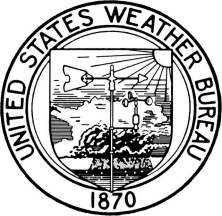 |
Brief History of National Weather Service Offices |
|
The National Weather Service (known before 1970 as the Weather Bureau) has had many offices. Many of them evolved as the aviation industry expanded, supporting local airport observations. Many also had varying warning and forecast duties. However, in the 1990's, the NWS was consolidated into 120+ offices, each with roughly the same duties.
The following is an attempt to list all past and present NWS/WB offices. If you have information on any of these, or ones that were missed, please contact Chris.Geelhart@noaa.gov . Several offices have more detailed histories available, which can be accessed by clicking on the city name.
Other NWS history pages:
| Forecast and Observation Sites | National Sites | |
|
AWSC -- Agricultural Weather Service Center |
WBO -- Weather Bureau Office WBAS -- Weather Bureau Airways Station WBFC -- Weather Bureau Forecast Center WBMO -- Weather Bureau Meteorological Observatory WFO -- Weather Forecast Office WSO -- Weather Service Office WSFO -- Weather Service Forecast Office WSMO -- Weather Service Meteorological Observatory WSCMO -- Weather Service Contract Meteorological Observatory |
HC -- Hurricane Center HQ -- Regional/National Headquarters NMC -- National Meteorlogical Center NCEP -- National Centers for Environmental Prediction TC -- Training Center TWC -- Tsunami Warning Center |
                                                     |
Signal Service Years:
No distinction has been made on these pages to delineate the types of station types used by the U.S. Army during the Signal Service era.
Weather Bureau Years:
When the Weather Bureau took over in 1891, there was generally a single type of field office, called a Weather Bureau Office (WBO). Some delineation was made during the early 1900's when forecast functions started to take place in the field (rather than all at Weather Bureau headquarters); offices with these forecast functions were referred to as District Forecast Offices. Some offices also began to perform river forecasts; originally referred to as River District Offices, the network was realigned and evolved into the River Forecast Center (RFC) network currently in use.
As the aviation industry began to play a larger role in the 1920's and 1930's, many locations began to operate a second Weather Bureau office at airports. These were initially referred to as Weather Bureau Airways Stations (WBAS). Eventually in the 1940's and 1950's, the split operations were frequently consolidated at the airport location, although some locations maintained separate facilities. There were also specialized forecast centers that performed aviation forecasts, referred to as Flight Advisory Weather Service stations (a forerunner to the current Center Weather Service Unit).
Weather Bureau sites that performed forecast functions were later referred to as Weather Bureau Forecast Offices (WBFO); the smaller sites peforming warning and local observation functions used the WBO terminology. Some smaller offices only conducted meteorologial observations (such as radar or upper air functions), and were referred to as Weather Bureau Meteorological Observatories (WBMO).
Weather Service Years:
When the Weather Bureau became the National Weather Service in 1970, generally the only thing that changed was the terminology. Thus, WBFO became Weather Service Forecast Office (WSFO), WBO became Weather Service Office (WSO), and WBMO became Weather Service Meteorological Observatory (WSMO). Some changes were made in the early 1970's to add additional WSFO's, increasing the total to 53.
During the NWS modernization of the 1990's, the network of stations was realigned and consolidated. Most of the remaining field offices became Weather Forecast Offices (WFO), all with roughly the same forecast and warning duties. Some of the WSO sites remained in operation, mainly in Alaska and the Pacific territories, although a few also operated in the contiguous U.S. for several additional years. Former WSO sites in Hawaii became Data Collection Offices, similar in concept to a Weather Service Meteorological Observatory.